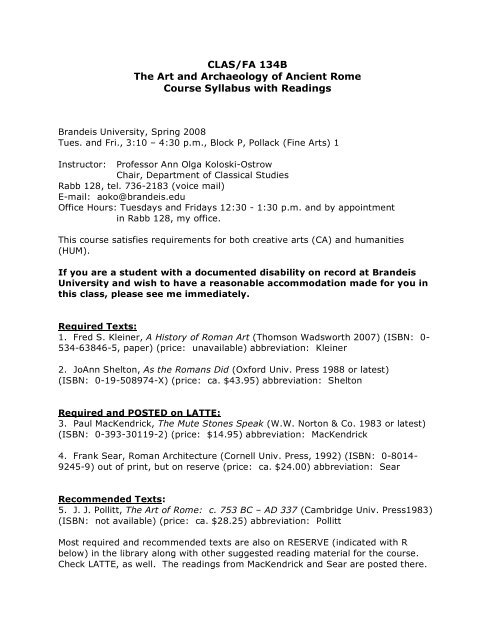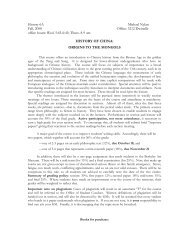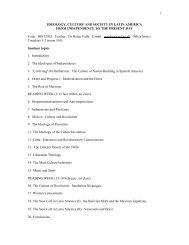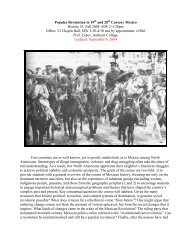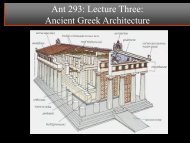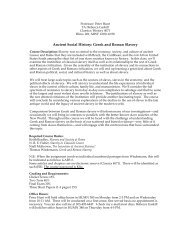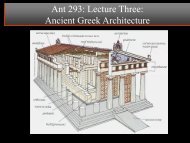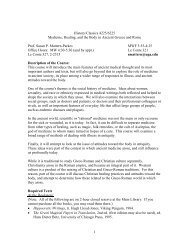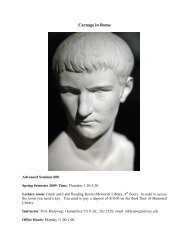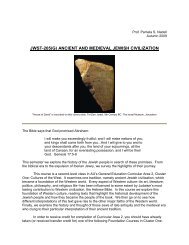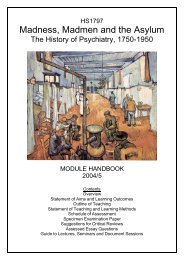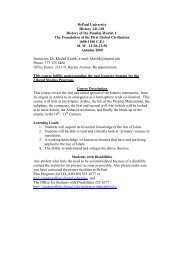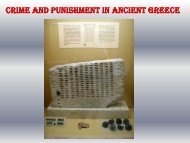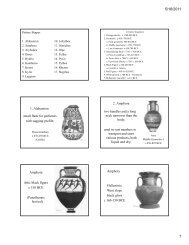CLAS/FA 134B The Art and Archaeology of Ancient Rome Course ...
CLAS/FA 134B The Art and Archaeology of Ancient Rome Course ...
CLAS/FA 134B The Art and Archaeology of Ancient Rome Course ...
Create successful ePaper yourself
Turn your PDF publications into a flip-book with our unique Google optimized e-Paper software.
<strong>CLAS</strong>/<strong>FA</strong> <strong>134B</strong><strong>The</strong> <strong>Art</strong> <strong>and</strong> <strong>Archaeology</strong> <strong>of</strong> <strong>Ancient</strong> <strong>Rome</strong><strong>Course</strong> Syllabus with ReadingsBr<strong>and</strong>eis University, Spring 2008Tues. <strong>and</strong> Fri., 3:10 – 4:30 p.m., Block P, Pollack (Fine <strong>Art</strong>s) 1Instructor: Pr<strong>of</strong>essor Ann Olga Koloski-OstrowChair, Department <strong>of</strong> Classical StudiesRabb 128, tel. 736-2183 (voice mail)E-mail: aoko@br<strong>and</strong>eis.eduOffice Hours: Tuesdays <strong>and</strong> Fridays 12:30 - 1:30 p.m. <strong>and</strong> by appointmentin Rabb 128, my <strong>of</strong>fice.This course satisfies requirements for both creative arts (CA) <strong>and</strong> humanities(HUM).If you are a student with a documented disability on record at Br<strong>and</strong>eisUniversity <strong>and</strong> wish to have a reasonable accommodation made for you inthis class, please see me immediately.Required Texts:1. Fred S. Kleiner, A History <strong>of</strong> Roman <strong>Art</strong> (Thomson Wadsworth 2007) (ISBN: 0-534-63846-5, paper) (price: unavailable) abbreviation: Kleiner2. JoAnn Shelton, As the Romans Did (Oxford Univ. Press 1988 or latest)(ISBN: 0-19-508974-X) (price: ca. $43.95) abbreviation: SheltonRequired <strong>and</strong> POSTED on LATTE:3. Paul MacKendrick, <strong>The</strong> Mute Stones Speak (W.W. Norton & Co. 1983 or latest)(ISBN: 0-393-30119-2) (price: $14.95) abbreviation: MacKendrick4. Frank Sear, Roman Architecture (Cornell Univ. Press, 1992) (ISBN: 0-8014-9245-9) out <strong>of</strong> print, but on reserve (price: ca. $24.00) abbreviation: SearRecommended Texts:5. J. J. Pollitt, <strong>The</strong> <strong>Art</strong> <strong>of</strong> <strong>Rome</strong>: c. 753 BC – AD 337 (Cambridge Univ. Press1983)(ISBN: not available) (price: ca. $28.25) abbreviation: PollittMost required <strong>and</strong> recommended texts are also on RESERVE (indicated with Rbelow) in the library along with other suggested reading material for the course.Check LATTE, as well. <strong>The</strong> readings from MacKendrick <strong>and</strong> Sear are posted there.
<strong>Art</strong> <strong>and</strong> <strong>Archaeology</strong> <strong>of</strong> <strong>Ancient</strong> <strong>Rome</strong>, Syllabus <strong>and</strong> Readings 2<strong>Course</strong> Description:This survey course is designed to familiarize students with the art <strong>and</strong> architecture<strong>of</strong> ancient <strong>Rome</strong>, from the founding <strong>of</strong> the city to the end <strong>of</strong> the Empire. Weconsider monumental <strong>and</strong> domestic architecture, wall painting, mosaics, sculpture,occasional coins <strong>and</strong> epigraphic evidence, as well as maps <strong>and</strong> ancient sources. Inaddition to ancient <strong>Rome</strong> itself, Pompeii, Herculaneum, <strong>and</strong> Ostia, various cities inthe provinces are also examined in some detail in order to provide underst<strong>and</strong>ing <strong>of</strong>the original contexts for these media. We want to know how ancient art <strong>and</strong>objects <strong>of</strong> daily life were used, viewed, <strong>and</strong> appreciated by their original patrons<strong>and</strong> owners as well as how to recognize <strong>and</strong> date them. If you take the courseseriously, you will time travel to ancient <strong>Rome</strong>, <strong>and</strong> that is an aerobic exercise, Ipromise.<strong>Course</strong> Requirements:1. You should be present (in mind <strong>and</strong> body) <strong>and</strong> participate as actively as you c<strong>and</strong>uring lectures, discussions, <strong>and</strong> any out-<strong>of</strong>-class activities or fieldtrips. Questionsare always welcome <strong>and</strong> encouraged. Class attendance will be taken on a regularbasis, orally at the beginning <strong>of</strong> the term so that your pr<strong>of</strong>essor can get to knowyou, <strong>and</strong> then by sign-in sheets distributed at the beginning <strong>of</strong> every class. Pleasenote that it quickly becomes apparent who is present <strong>and</strong> who is not, especiallyfrom the class sign-in sheets, but it is important that you come to class.2. You must complete all assigned readings (from required texts <strong>and</strong> from books<strong>and</strong> articles posted on LATTE). Your appreciation <strong>and</strong> underst<strong>and</strong>ing <strong>of</strong> lectures <strong>and</strong>discussions will be greatly enhanced if you complete reading assignments by theirdue date. This syllabus contains assignments from your required <strong>and</strong>recommended texts (<strong>and</strong> from various books on the reserve reading or itemsposted from time to time on LATTE) for the semester. Since my lectures areoriginal creations, you are advised *not* to miss them. Many points made in themcannot be found in the required or reserve reading.3. You will also take one short map quiz (on geography, possibly with someterminology). <strong>The</strong> map quiz is announced in advance (scheduled for Tuesday,February 5, 2008) so that you have time to prepare yourselves. Study guides willbe provided <strong>and</strong> posted on LATTE. This quiz is not given to cause you unnecessarystress or anxiety. Rather it will assure your pr<strong>of</strong>essor <strong>and</strong> you that you are not lost(literally <strong>and</strong> figuratively). Just as it is crucial that you learn to recognize for alltime certain important objects, plans, <strong>and</strong> architectural remains as one <strong>of</strong> the mainobjectives <strong>of</strong> the course, you should have a good sense <strong>of</strong> the topography <strong>and</strong>geography we shall travel together, <strong>and</strong> a sense <strong>of</strong> some archaeologicalterminology <strong>and</strong> chronology. When you make your next trip to the Mediterraneanworld (or your first trip) <strong>and</strong> to the ancient sites for yourself, you will be grateful forthis exercise. Sorry, no make-up quiz (unless you have a medical or other trulyvalid excuse issued in advance, if possible).4. You will take one midterm slide exam on Friday, March 7. 2008. (Sorry, nomake-up midterm exam is available.) If you must miss the midterm altogether forMEDICAL reasons or for some other VALID excuse, approved by your pr<strong>of</strong>essor,
<strong>Art</strong> <strong>and</strong> <strong>Archaeology</strong> <strong>of</strong> <strong>Ancient</strong> <strong>Rome</strong>, Syllabus <strong>and</strong> Readings 3preferably in ADVANCE, you may write a research paper [5-7 typed, double-spacedpages] to make up the omission.An optional research paper may also be completed by those <strong>of</strong> you with agrade lower than “B-” on the midterm slide exam. In this latter case, however, thegrade you receive on the research paper will be averaged with the grade youreceived on your midterm. <strong>The</strong> research paper’s grade, in other words, will *not*replace your entire exam with a new grade. Still, this option should produce amore satisfactory midterm grade, if taken seriously.5. You will also complete an object-based writing project (which includes a written<strong>and</strong> drawn object description). A full explanation will be forthcoming. This workwill require a sustained effort to be done well, <strong>and</strong> is due Tuesday, , 2008, the lastday <strong>of</strong> our class. You will have opportunities to consult with your pr<strong>of</strong>essor. Youwill lose one grade step for every day that your project is late (A+ to A to A- to B+--unless you have a medical or other truly valid excuse, presented IN ADVANCE, if atall possible). This assignment is instead <strong>of</strong> a final exam.<strong>Course</strong> Requirements with Approximate Grade Determination:1) Class attendance, participation <strong>and</strong> completion <strong>of</strong> reading assignments,prospectus for final paper. (20%)2) Map/Terminology quiz (Tues., Feb. 5) (20%)3) Midterm Exam (Fri., March 7) (30%)4) Object Project Assignment with Drawing, 5-6 pages(Tues., April 29, Br<strong>and</strong>eis Friday) (30%)Nota Bene: <strong>The</strong> optional research paper can be worth 30% for the midtermONLY if you have special permission from your pr<strong>of</strong>essor to use it to replace themidterm exam. If written to improve a poor midterm grade, the paper’s grade willbe averaged with your midterm grade to produce your new midterm grade.Total: (100%)Academic Honesty (last, but hardly least!):You are expected to be honest in all <strong>of</strong> your academic work. Br<strong>and</strong>eisUniversity policy on academic honesty is contained in your Student H<strong>and</strong>book insection 5 under “Rights <strong>and</strong> Responsibilities.” Instances <strong>of</strong> cheating, plagiarism, orother alleged dishonesty will be reported to the Office <strong>of</strong> Campus Life for possiblereferral to the Student Judicial System. <strong>The</strong> adjudication process is also outlined inyour H<strong>and</strong>book. Potential consequences <strong>of</strong> academic dishonesty include (inaddition to an “E” on the assignment) failure in the course, disciplinary probation,<strong>and</strong> suspension from the University. A record <strong>of</strong> any <strong>of</strong>fense will remain in astudent’s disciplinary file in the Office <strong>of</strong> Student Affairs throughout his or hercareer at Br<strong>and</strong>eis. Please know that I take this code very seriously. If you haveany questions about my expectations, please ask me.Lecture topics for the entire semester are listed by date below, along withdue dates for assignments, field trips, special events, <strong>and</strong> special lectures. Assignedreadings are included.
<strong>Art</strong> <strong>and</strong> <strong>Archaeology</strong> <strong>of</strong> <strong>Ancient</strong> <strong>Rome</strong>, Syllabus <strong>and</strong> Readings 4Please contact me if you have questions about the readings.JANUARYTuesday, January 15 What is Roman art, <strong>and</strong> why study it?Required: Buy books.Recommended: Kleiner preface; xvii-xviii; R&R 7-23(Intro.).Friday, January 18Tuesday, January 22Friday, January 25Tuesday, January 29FEBRUARYFriday, February 1Roman Topography <strong>and</strong> Chronology; Who were theRomans? How do we know them?Required: Kleiner 1-15 (ch. I); Sear 10-28 (ch. 1), 29-48 (ch. 2) (R <strong>and</strong> LATTE).Recommended: MacKendrick 1-27 (ch. 1) (R <strong>and</strong>LATTE); Pollitt 3-57 (ch. 1); Ramage <strong>and</strong> Ramage 24-45(ch 1).Roman Forerunners: Villanovans, Etruscans, <strong>and</strong>Greeks (1000-200 B.C.E.)Required: Kleiner review 1-15 (ch. I); Sear review 10-28(ch. 1), 29-48 (ch. 2) (R <strong>and</strong> LATTE); Recommended:MacKendrick 28-70 (ch. 2) (R <strong>and</strong> LATTE); Ramage <strong>and</strong>Ramage 48-55 (rest <strong>of</strong> ch 1); rev. Pollitt 3-57 (ch. 1);McKay, A.G. Vergil's Italy (Bath, 1970) 147-193 (R);Salmon, E.T. “<strong>Rome</strong> <strong>and</strong> the Latins,” Phoenix VII.3(1953) 93-104; Salmon, E.T. Samnium <strong>and</strong> the Samnites(Cambridge, 1967) (R); Paget, R. F. Central Italy: AnArchaeological Guide (London, 1973).Italian Prehistory in <strong>Rome</strong>; Introduction to the earlyRoman Forum <strong>and</strong> the Republican Townscape.Required: Kleiner 18-29 (ch. II); Sear, review 29-48(ch. 2) (R <strong>and</strong> LATTE); Shelton chs. II, III, IV, XI (R).Recommended: MacKendrick 71-112 (ch. 3), 113-140(ch. 4) (R <strong>and</strong> LATTE); Ramage <strong>and</strong> Ramage 56-81 (ch.2); Dudley, Urbs Roma, 3-9 (Site <strong>of</strong> <strong>Rome</strong>), 34 (ServianWall), 43-47 (Tiber) (R).More on the Roman Republic <strong>and</strong> its MonumentsRequired: Kleiner 31-45 (ch. III) <strong>and</strong> 47-59 (ch. IV).Recommended: MacKendrick 113-140 (ch. 4) (R <strong>and</strong>LATTE); Ramage <strong>and</strong> Ramage 82-95 (rest <strong>of</strong> ch. 2);Nash, Pictorial Dictionary 1 & 2, (individual monuments <strong>of</strong>Forum Romanum) (ch. 5) (R).Hellenistic <strong>Rome</strong>; Julius Caesar <strong>and</strong> the End <strong>of</strong> Republican<strong>Rome</strong>Required: Kleiner review 47-59 (ch. IV); Sear 69-85(ch. 4) (R <strong>and</strong> LATTE); Shelton chs. VII, IX, X, XIII (R);MacKendrick 141-177 (ch. 5) (R <strong>and</strong> LATTE).
<strong>Art</strong> <strong>and</strong> <strong>Archaeology</strong> <strong>of</strong> <strong>Ancient</strong> <strong>Rome</strong>, Syllabus <strong>and</strong> Readings 5Recommended: Ramage <strong>and</strong> Ramage review 56-95(ch. 2); Pollitt 58-98 (rest <strong>of</strong> ch. 1).Tuesday, February 5Friday, February 8Tuesday, February 12Friday, February 15Brick into Marble, or Augustan <strong>Rome</strong> I: Gods,Temples & Other ArchitectureMap/Terminology quizRequired: Kleiner 61-77 (ch. V); MacKendrick 178-215(ch. 6) (R <strong>and</strong> LATTE); Shelton chs. IV, V, VIII, XIV (R).Recommended: Ramage <strong>and</strong> Ramage 96-131 (ch. 3);Pollitt 99-139 (ch. 2).Augustan <strong>Rome</strong> II: Sculpture, Portraiture, the Minor <strong>Art</strong>s(Glass) <strong>and</strong> the Pax AugustaRequired: Kleiner 79-87 (ch. VI) <strong>and</strong> 89-101 (ch. VII);Sear 49-68 (ch. 3) (R <strong>and</strong> LATTE).Recommended: Dudley, Urbs Roma, 9-17(Republic), 51-119 (Capitol <strong>and</strong> Roman Forum) (R);Nash, Pic. Dic. 1, 63-73 (Ara Pacis), 310-315 (House<strong>of</strong> Augustus), 401-410 (Forum <strong>of</strong> Augustus), 446-449(Forum Romanum) (R); Ramage <strong>and</strong> Ramage 132-152(ch. 4).<strong>The</strong> Julio-Claudians I: Tiberius through Gaius (Caligula)Required: Kleiner 103-108 (ch. VIII); Sear 69-102(chs. 4-5) (R <strong>and</strong> LATTE); Pollitt, 99-136;MacKendrick 216-43 (ch 7, Hypocrite, Madman...)(R <strong>and</strong> LATTE);Recommended: Boëthius <strong>and</strong> Ward- Perkins, Etruscan<strong>and</strong> Roman Architecture, chapters relevant Tiberiusthrough Gaius (Caligula) (R); review Ramage <strong>and</strong>Ramage 132-153 (ch. 4).<strong>The</strong> Julio-Claudians II: Claudius to NeroRequired: Kleiner 109-119 (rest <strong>of</strong> ch. VIII); reviewSear 69-102 (chs. 4-5) (R <strong>and</strong> LATTE); reviewMacKendrick 216-43 (ch 7, Hypocrite, Madman...) (R <strong>and</strong>LATTE).Recommended: Pollitt, 136-150; Boëthius <strong>and</strong> Ward-Perkins, Etruscan <strong>and</strong> Roman Architecture,chapters relevant Claudius to Nero (R); reviewRamage <strong>and</strong> Ramage 132-153 (ch. 4).Saturday, February 16 – Sunday, February 24, no classes (Mid-TermRecess)Tuesday, February 26Vesuvian Cities <strong>of</strong> Pompeii <strong>and</strong> HerculaneumBackground, History, <strong>and</strong> Excavation <strong>of</strong> aLaboratory <strong>of</strong> Roman Life
<strong>Art</strong> <strong>and</strong> <strong>Archaeology</strong> <strong>of</strong> <strong>Ancient</strong> <strong>Rome</strong>, Syllabus <strong>and</strong> Readings 6Friday, February 29MARCHTuesday, March 4Friday, March 7Tuesday, March 11Friday, March 14Required: review Kleiner 18-29 (ch. II) <strong>and</strong> 31-45(ch. III); MacKendrick 244-81 (ch. 8, Victims <strong>of</strong>Vesuvius) (R <strong>and</strong> LATTE); Etienne, Pompeii <strong>The</strong>Day a City Died (selections in LATTE).Recommended: see Reserve books on Pompeii.Vesuvian Cities: Public LifeRequired: Kleiner 139-151 (ch. X); review MacKendrick244-81 (ch. 8, Victims <strong>of</strong> Vesuvius) (R <strong>and</strong> LATTE);Shelton chs. IV, VII, XIV, XV R; Sear ch 6, 103-118 (R<strong>and</strong> LATTE).Recommended: Mau/Kelsey, Pompeii: Its Life <strong>and</strong><strong>Art</strong>, 1-44 (R); Ward-Perkins, Etruscan <strong>and</strong> RomanArchitecture, ch. on Pompeii (R); Grant, Cities <strong>of</strong>Vesuvius, 89-220 (chs. 4-8, Epilogue) (R); browsereserves for other things <strong>of</strong> interest.Vesuvian Cities: Private LifeRequired: review Kleiner 139-151 (ch. X); reviewMacKendrick 244-81 (ch 8, Victims <strong>of</strong> Vesuvius) (R<strong>and</strong> LATTE); Shelton chs. V, VIII, XIII(R); review Sear 103-118 (ch 6) (R <strong>and</strong> LATTE).Recommended: see above, last lecture; Grant,Eros at Pompeii (R); Grant, Cities <strong>of</strong> Vesuvius 15-24, 25-44, 45-88 (chs. 1, 2, 3) (R); Etienne, Pompeii <strong>The</strong> Day aCity Died (selections in LATTE); Mau/Kelsey, Pompeii:Life <strong>and</strong> <strong>Art</strong>, 245-279 (<strong>The</strong> Pompeian House) (R).Midterm Exam (no make-ups, please, unlessextreme circumstances discussed in advance if at allpossible) You should have read all REQUIRED readingswell before the exam.Finish Private Life/ View Pompeii VideoRequired: review readings from last lecture before themidterm, especially Kleiner 139-151 (ch. X).Recommended: review readings from last lecturebefore the midterm.Roman Villas Architecture <strong>and</strong> DecorationRequired: review Shelton chs. VIII <strong>and</strong> XIV (R).Recommended: Jashemski, Gardens <strong>of</strong> Pompeii vol. 1,especially chs. 1 <strong>and</strong> 16; Mau/Kelsey, Pompeii: Its Life<strong>and</strong> <strong>Art</strong>, 45-60, 221-226 (R); Etienne, Pompeii <strong>The</strong> Day aCity Died (sections in LATTE); review Ramage <strong>and</strong>Ramage on Augustus <strong>and</strong> Julio-Claudians 96-153 (chs. 3,4).
<strong>Art</strong> <strong>and</strong> <strong>Archaeology</strong> <strong>of</strong> <strong>Ancient</strong> <strong>Rome</strong>, Syllabus <strong>and</strong> Readings 7Sunday, March 16Tuesday, March 18Friday, March 21Tuesday, March 25Friday, March 28APRILTuesday, April 1Required Fieldtrip: Boston Museum <strong>of</strong> Fine <strong>Art</strong>sWorkshop on Object Projects; details TBA.(If you are not able to make this fieldtrip, you canarrange to go on your own with a sheet provided by Pr<strong>of</strong>.AOK-O.)<strong>The</strong> Flavian EmperorsRequired: Kleiner 121-137 (ch. IX); Sear 134-153 (ch.7) (R <strong>and</strong> LATTE); MacKendrick 282-313 (ch 9) (R <strong>and</strong>LATTE).Recommended: Pollitt 150-165; Ramage <strong>and</strong> Ramage154-185 (ch 5); Boëthius <strong>and</strong> Ward-Perkins, Etruscan <strong>and</strong>Roman Architecture, ch. on Flavian architecture (R).Good Friday, no class.TrajanRequired: Kleiner 153-169 (ch. XI); Sear 154-165 (ch.8) (R <strong>and</strong> LATTE); MacKendrick 314-241 (ch. 10) (R <strong>and</strong>LATTE)Recommended: Boëthius <strong>and</strong> Ward-Perkins, Etruscan<strong>and</strong> Roman Architecture, ch. on Trajan (R); Ramage <strong>and</strong>Ramage 186-205 (ch. 6).Ostia: the Port Town <strong>of</strong> <strong>Rome</strong>One-Page Prospectus for Object Project DueRequired: review Kleiner 153-169 (ch. XI) <strong>and</strong> read 203-215 (ch. XIV); Sear 118-133 (ch. 6) (R <strong>and</strong> LATTE).Recommended: Boëthius <strong>and</strong> Ward-Perkins,Etruscan <strong>and</strong> Roman Architecture, chaptersrelevant to Ostia (R); Meiggs, Roman Ostia (R); reviewRamage <strong>and</strong> Ramage 186-205 (ch. 6).Hadrian, the Revival <strong>of</strong> Classical Greek <strong>Art</strong>, <strong>Rome</strong>,<strong>and</strong> his Villa at TivoliRequired: Kleiner 171-185 (ch. XII); Sear 165-184(ch. 8) (R <strong>and</strong> LATTE); MacKendrick 342-373 (ch.11) (R <strong>and</strong> LATTE);Recommended: Boëthius <strong>and</strong> Ward-Perkins,Etruscan <strong>and</strong> Roman Architecture, chapter relevantto Hadrian (R); Boatwright, Hadrian <strong>and</strong> the City <strong>of</strong><strong>Rome</strong>; Ramage <strong>and</strong> Ramage 206-233 (ch. 7); Pollitt165-186.
<strong>Art</strong> <strong>and</strong> <strong>Archaeology</strong> <strong>of</strong> <strong>Ancient</strong> <strong>Rome</strong>, Syllabus <strong>and</strong> Readings 8Friday, April 4Tuesday, April 8Friday, April 11Tuesday, April 15Friday, April 18Roman Towns in the Provinces (East, West, <strong>and</strong>North Africa)Required: Kleiner 247-261 (ch. XVII); Sear 185-209(ch. 9), 210-230 (ch. 10), <strong>and</strong> 231-254 (ch. 11) (R <strong>and</strong>LATTE).Recommended: Boëthius <strong>and</strong> Ward-Perkins,Etruscan <strong>and</strong> Roman Architecture, chapter relevant toEastern, Western, <strong>and</strong> North African provinces (R);review Pollitt 165-186.<strong>The</strong> Antonines <strong>and</strong> Severans: Triumphal Arches,Public Works, <strong>and</strong> SculptureRequired: Kleiner 187-201 (ch. XIII), 217-229 (ch. XV),<strong>and</strong> 231-245 (ch. XVI); MacKendrick 374-419 (ch 12,Antonines through Constantine, 138-377 C.E.) (R <strong>and</strong>LATTE).Recommended: Boëthius <strong>and</strong> Ward-Perkins, Etruscan<strong>and</strong> Roman Architecture, chapter relevant to period (R);Pollitt 189-201; Ramage <strong>and</strong> Ramage 234-257, 258-283(chs. 8, 9).<strong>The</strong> Soldier Emperors/ Crisis <strong>of</strong> the Third Century;<strong>The</strong> TetrarchsRequired: Kleiner 263-277 (ch. XVIII) <strong>and</strong> 278-289 (ch.XIX); review Sear 255-276 (ch 12) (R <strong>and</strong> LATTE).Recommended: MacKendrick 420-445 (ch. 13) (R <strong>and</strong>LATTE); Boëthius <strong>and</strong> Ward-Perkins, Etruscan <strong>and</strong> RomanArchitecture, chapter relevant to period (R); Pollitt 201-213; Ramage <strong>and</strong> Ramage 284-295, 296-311 (chs. 10,11).Constantine; a New <strong>Rome</strong>Required: Kleiner 290-306 (ch. XX).Recommended: Boëthius <strong>and</strong> Ward-Perkins, Etruscan<strong>and</strong> Roman Architecture, chapter relevant to period (R);review Pollitt 201-213; Ramage <strong>and</strong> Ramage 312-335 (ch12).Retrospective <strong>of</strong> the <strong>Course</strong>Saturday, April 19 to Sunday, April 27, Passover/Spring Break, no classes.Tuesday, April 29<strong>Course</strong> Wrap-upTips on Traveling to <strong>Rome</strong>Object Projects Due on Tuesday, April 29, aBr<strong>and</strong>eis Friday.


